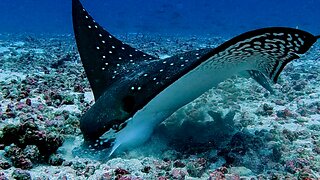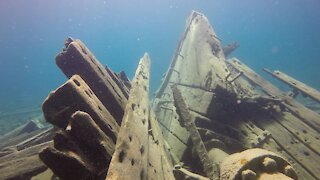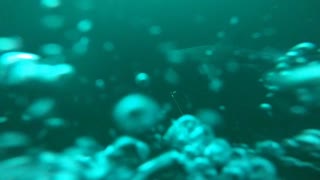Premium Only Content

Divers explore the ghostly wreck of Russian destroyer gunship #356
Eighty feet beneath the waves near Cayman Brac Island lies the wreck of Russian built destroyer #356. It was built in 1984 by the U.S.S.R. for the Cuban navy. Although it did not participate in any notable battles, it was a fully equipped gunship with turrets on the stern and the bow. It was sold to the Cayman islands in 1996 and sunk to create an artificial reef and dive exploration site. At that tie, it was renamed the Captain Keith Tibbetts in honor of a local dive operator. A carefully planned sinking, attended by Jean-Michel Cousteau, left the 330 foot frigate resting on a sandy area near the wall off the north side of the island. The stern is in 60 feet of water and the bow is 85 feet deep. The ship was broken and shifted during the pummeling of the coast by Hurricane Ivan in 2004. This left some of the ship’s structure scattered as debris in the sand. It also left the bow tipped over more dramatically.
The ship has provided an ideal surface for the growth of sponges and coral. Together with the structure of the ship, this has drawn marine life such as small fish, barracudas, groupers, and even critically endangered Hawksbill sea turtles. These rare and beautiful turtles feed primarily on sponges and the algae that grow on them. Scuba divers are also drawn to the Tibbetts, and exploration of the interior, known as penetration diving, is a fascinating experience. The ship has a mysterious and ghostly presence as one swims over it and marvels at the gun turrets, controls, and beams that are much as they would have been 35 years ago when the ship was in service. To swim through rooms and hallways that had been walked by soldiers three and a half decades ago is an eerie experience. Cables and brackets hang from the walls and the floors are tilted unnaturally. The impressive size of the ship also makes an impact on a scuba diver who descends from above to greet this huge destroyer.
These divers explored the wreck for almost an hour before their air supply ran low and it was time to make their way back to the surface.
-
 0:57
0:57
WildCreatures
5 days ago $0.40 earnedIncredible close up footage of spotted eagle ray eating
2.47K6 -
 3:23
3:23
WildCreatures
4 years ago $0.31 earnedScuba divers explore an eerie shipwreck in Devil Island Channel
3.24K2 -
 0:56
0:56
ViralHog
4 years ago $0.03 earnedShrimp Gives Divers French Manicures
245 -
 1:54
1:54
WildCreatures
4 years ago $0.20 earnedScuba divers explore the depths of the mysterious Great Blue Hole in Belize
1.9K1 -
 2:17
2:17
WildCreatures
4 years ago $0.17 earnedMysterious caves await adventurous scuba divers in Tobermory, Canada
3.14K7 -
 1:44
1:44
WildCreatures
5 years ago $0.13 earnedFree divers explore Tonga's mysterious and beautiful Swallow's Cave
1.75K -
 4:01
4:01
ViralHog
4 years agoReef Shark Swims Near Divers off Coast of Pensacola
1591 -
 1:19
1:19
KristysWorld
4 years ago $2.82 earnedScuba diver explores mysterious WWII fighter plane wreck
3.69K -
 1:23
1:23
WildCreatures
4 years ago $0.01 earnedScuba divers enter a world that is beautiful beyond words
1.59K1 -
 0:25
0:25
ItsDefty
3 years agoMonkey Russian
31